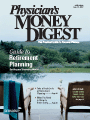Incorporate the New Rules of Retirement
Early retirement" has become an oxymoron.Today, it is not time to retireuntil you are prepared for almost everyeventuality, including the loss of some ofyour investment principal. While normalretirement age is 65, the IRS says you canretire early at age 59 1/2. Yet, babyboomers feel cheated if they can't retireat a much younger age. But let's thinkabout reality; the economy and the stockmarket are not cooperating. If you arewilling to downsize your house, yourcars, your monthly spending sprees, andyou have no debt, it is possible to successfullyquit "for good" before 59 1/2.For many people, that's too big a sacrifice.
EARLY BIRD TROUBLES
The Center for Strategic and InternationalStudies stated in its report, The21st Century Retirement Security Plan,that as a country, we are not ready forretirement: "We are confronted with arapidly aging population, actuariallyunsound federal health and retirementprograms, unsustainable trends of spendingfor government programs for seniorcitizens, and inadequate levels of privatesavings. We have promised too much collectivelyand set aside too little individually.As a result, the proverbial ‘3-leggedstool' of resources for retirement security—Social Security, private pension plans,and personal savings—that traditionallyhas financed Americans' retirement isincreasingly unstable and in need ofrepair." This report, which was presentedin 1998 (before the tech stock bubble,accounting fraud, and falling stock priceswere on the radar), is truer than ever.
Lately, I've had the sad duty of tellingseveral retirees that they were going tohave to get back to earning an income.Believe me, it is much harder for themto go back to work than it would havebeen to stay in their original careers. Asfor good news, retirees don't need tomake as much money as they did priorto retirement. They no longer need tofund an IRA or 401(k), for one thing.They have often paid off their primaryresidences and other long-term indebtedness.Hopefully their children are self-sufficient;if not, it's critical that theretiree does not make financial gifts orloans to family members.
And the new job does not have to beone with a high level of stress or status,like a fast-paced medical practice. It isonly a temporary position to earn cash. Itmight even be an extension of a life-longlove outside of medicine, such as teaching,landscaping, or cooking. If you aretrying to determine whether or not toretire in the near future, I recommendtaking a strong look at the numbers inyour portfolio and checkbook and askingyourself the following questions:
- How much will you spend annuallyduring retirement?
- What's the total amount youwill need from various sources (eg,Social Security, pension, savings,investments, etc) to produce thatannual income?
- Will your current resources getyou to this goal?
- If not, how should you adjustyour financial strategy?
- If some or all your investmentsfail to produce the expected yieldor even go into negative numbers,how would you plan to replace thatexpected income?
- If you averaged a 10% yield onyour investments throughout yourworking life, how many years of noyield or investment losses couldyour retirement withstand?
STARK REALITIES
Passages
New
Passages
Sixty-five is looking younger andyounger all the time. author Gail Sheehy used to refer tothe 40s as being a person's middlepassage. In her updated , she moved that period upto the 50s. It's wonderful that ourlife expectancy has increased, buteach year that we live beyond 65 isanother year that we will have tofinance in retirement.
In 2000, The Adam Smith Institutesuggested that most of today'sBritish teenagers will be alive andactive at age 100. If that is correct,and they plan to retire at 65 or soonthereafter, they have a lot of savingto do. If Social Security and pensionsor other investments fail, 2 legs ofthe 3-legged stool will have fallenaway, leaving retirees to survive ontheir personal savings and nothingelse. In the next 40 years, the numberof people over age 65 is expectedto double, making up as much as20% of the total population. Whilein 1960, 6 workers supported eachSocial Security beneficiary, that isprojected to drop to only 2 workersby the year 2030.
As retirement age approaches,investors should be lowering theirrisk tolerance. However, with the increasedpressure to retire by a certaindate, more than 1 potentialretiree has decided to move intoriskier investments to make up forunsuccessful investments in the past.This is a recipe for financial disaster,especially in uncertain times such asthese. When the market does recover(and one day it will), you can onceagain quit working and start spending.However, for now, keep yournest egg viable by developing a solidfinancial plan and reinvesting someor all of your income.
Kay R. Shirley, president of Financial Development Corp, is a registered representative,
registered principal, and branch manager for Mutual Service Corp, member NASD/SIPC.
Author of Live Long and Profit and The Baby Boomer Financial Wake-Up Call, she welcomes
questions or comments at 404-261-2221, kshirl@bellsouth.net, or www.kayshirley.com.
